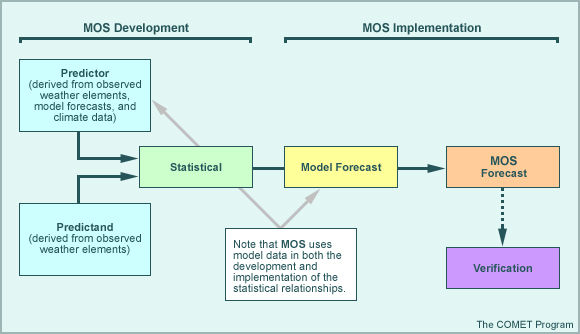Model Output Statistics (MOS)
The MOS technique develops relationship equations from both observed and model forecast weather elements, which are then applied to raw model output (the same or similar model) to produce statistical guidance. MOS is used frequently in the National Weather Service. Because MOS uses NWP output in both the development and implementation of the statistical equations, time lag can be incorporated into the relationships as well as an accounting of certain systematic model errors such as a dry bias.
For example, forecasters unconsciously apply the MOS technique subjectively when using model forecasts of 70% RH to estimate cloud forecasts. This practice may work in a number of cases but a problem arises when the model has a dry or wet bias and lower/higher model RH values are not used to estimate clouds. In the case of a dry bias, if the forecaster does not account for the lower model RH values by using model RH values of less than 70%, clouds are likely to be underforecast by the model and the forecaster. Even if the forecaster does make some adjustment by using 60 or 65% RH, the selection of these values is somewhat subjective and not necessarily based on an established relationship. However, if MOS guidance is used to estimate the clouds, the statistical relationships developed for that model will already take into account such systematic errors as the dry bias.

Advantages
- Because historical model data is used in development
- MOS can account for systematic model errors and deteriorating model accuracy at greater forecast projections.
- MOS can account for the predictability of model variables by selecting those that provide more useful forecast information. For example:
- Using 850-hPa temperature forecasts as opposed to 2-m temperature forecasts to generate surface temperature guidance where the 850-hPa temperature is typically more accurately forecast
- Multiple predictors can be used, resulting in a better fit to the predictand data and generally more accurate guidance.
Limitations
- MOS requires a developmental dataset of historical model data that is used as the predictor.
- This can be inefficient, particularly in situations where the operational model suite is evolving (requires redevelopment of statistical relationships).For example:
- Improvements to model systematic errors will result in degraded MOS guidance until the developmental dataset is updated.
- This can be inefficient, particularly in situations where the operational model suite is evolving (requires redevelopment of statistical relationships).For example: